#Gaia Hypothesis (Theory)
Text
It is important that scientists working in chaos theory, biodiversity/Gaia studies, and post-Darwinian evolution acknowledge their genuine affinities with indigenous perspectives.
"Biological Exuberance: Animal Homosexuality and Natural Diversity" - Bruce Bagemihl
#book quote#biological exuberance#bruce bagemihl#nonfiction#scientists#chaos theory#biodiversity#gaia theory#gaia hypothesis#post darwinian evolution#indigenous knowledge#traditional knowledge
3 notes
·
View notes
Text
There is also little evidence to support the idea that homosexuality operates as a kind of large-scale "population-regulating" mechanism (perhaps the most obvious "function" that would be ascribed to homosexuality in a Gaian interpretation). Nevertheless, one of the fundamental insights of Gaia theory – the value it accords to "paradoxical" phenomena – is directly applicable to homosexuality and transgender.
"Biological Exuberance: Animal Homosexuality and Natural Diversity" - Bruce Bagemihl
#book quote#biological exuberance#bruce bagemihl#nonfiction#homosexuality#gay#lesbian#population control#population regulation#gaia theory#gaia hypothesis#paradox#transgender
0 notes
Photo
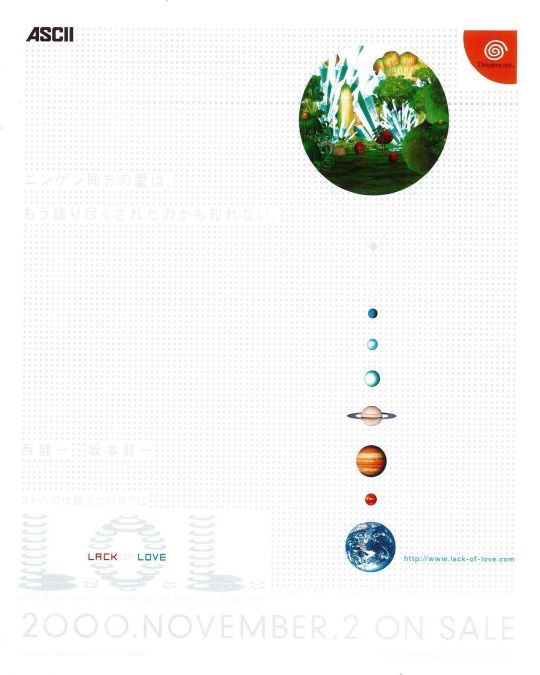
L.O.L: Lack Of Love is an evolutionary life simulation game developed by Love-de-Lic and published by ASCII Entertainment for the Sega Dreamcast. The game was released only in Japan on November 2, 2000.
The musical score for L.O.L.: Lack of Love was created by film composer Ryuichi Sakamoto, who was also the game's scenario writer. Nishi and Sakamoto met at Club Eden via a mutual friend and, through a series of e-mails, began discussing James Lovelock’s Gaia hypothesis. This theory states that the earth's living organisms function in harmony and respond to ecological changes in order for the planet to sustain life. Nishi explained about the game's message: "We should care for other people, life, the environment and nature. Sakamoto came up with the title. We wanted to question the way in which our lifestyle lacks love".
Sakamoto's 13-track score is made up of only abstract, synthesized electronic music with most of the songs composed to evoke a sense of a sadness or loneliness in the listener.
138 notes
·
View notes
Text
Untitled Wednesday Library Series, Part 114
Today's feature has been riding pine since Part 2 — I've glanced at it sidelong every week for two years and change, but the time has never felt right. It doesn't feel right now either, but I recently gave it a reread and might as well get it over with while the memory is fresh. This is a personal pseudo-favorite and probably one of the only things I own that could be called infamous (though admittedly only by a certain type of guy), but it's not especially easy to sum up.
A New Bacteriology, right? Originally published in 1980 as Introduction à la nouvelle bactériologie by the University of Montreal Press, this text has probably saw more distribution in this 1983 English translation under Jones and Bartlett Publishers, Inc. The frontmatter cites the whole 'staff for this book'; like last week I'll include a photo with the cover shots.
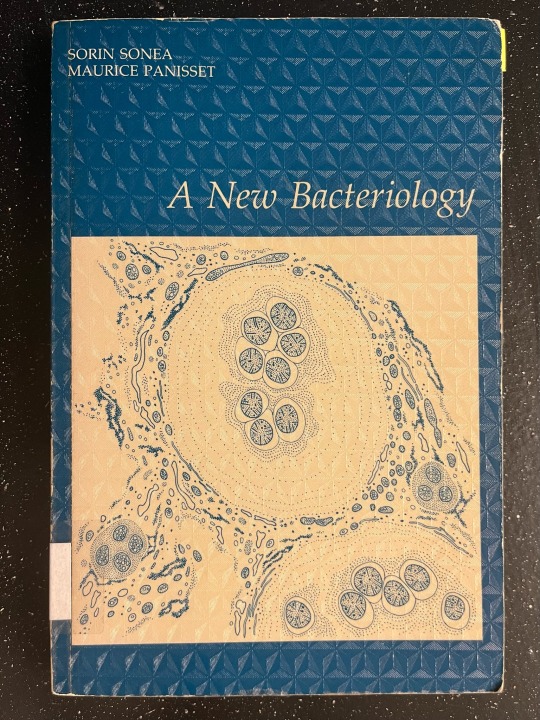



Evidently there exists an ISBN for a clothbound edition, but I’ve only ever seen the paperbacks.
The How
I probably first encountered the title in a David Quammen book or something, but I didn't hunt down a copy until I made friends with a former professor in the philosophy of biology. He didn't/doesn't work on systematics, but somehow or another this got mentioned and I found a used copy on eBay. This has never been reprinted and scans are scarce; these days the online secondhand market seems spooky. As always, let me know if you want a look inside and I'll hook you up.
The Text
I can't say much about either author — Panisset died in '81 and I frankly haven't bothered to track down any of Sonea's other stuff. Microbiologists both, of course, working while the field was in profound flux. Endosymbiotic theory had only been substantiated by Lynn Margulis in '67, and Archaea weren't defined until a decade later, in the early stages of this book's composition. Both of those are important here.


This is not a gentle book. It's a manifesto with several interests, most salient of which is the argument that various modes of horizontal gene transfer, limited local genetic information, and co-evolution of bacterial 'teams' makes all 'bacteria' (these days we'd say prokaryotes; the usually mean to include what we'd now call Archaea) parts of a global superorganism. Under this view, species are bunk; bacteriophages are less virus and more a tool of bacterial evolution; most microbiologists are basically close-minded. Oh, and because of all of that, the Gaia hypothesis is correct. There's a lot going on here. Lynn Margulis wrote the intro to this version and is mentioned several times throughout, if you can imagine that. I do not have enough space here to say all I want to about that and her, so let it suffice that it makes complete sense she went to bat for this.
If the book is interesting for anything, it's the way it goes about structuring its arguments. It is basically a philosophical artifact; there's no new wet work going on at all, and appeals to, say, numbers and novel observations and discrete mechanisms are sparse. That it works like a philosophy of biology book but is aimed at biologists as such is probably its greatest rhetorical weakness (if you’re not counting the usually Gaia stuff). There are some fascinating rhetorical slants going on around gene transfer mechanisms that I'll mention exist; say so if you want to hear more.
If their gripes about their field hold any water, there are some deep and complicated implications for the rest of biology in light of work done since the 80s. The conclusions drawn here are often silly, mostly toothless, and politically a bit dicey, but some of their insights have (through other channels, usually with different flavors) come to widespread, if tacit, acceptance anyway. I think I'm comfortable calling this recommended, but certainly not endorsed, reading.
The Object
Eh. Small publishing house doing what it could with a rather complicated job. The typesetting and printing is completely adequate but a little frustrating in the way that basically all biology writing is. The early 80s were especially bland in scientific publishing; absolutely no frills or risky moves. A bit of a shame, but I'm used to the disappointment.
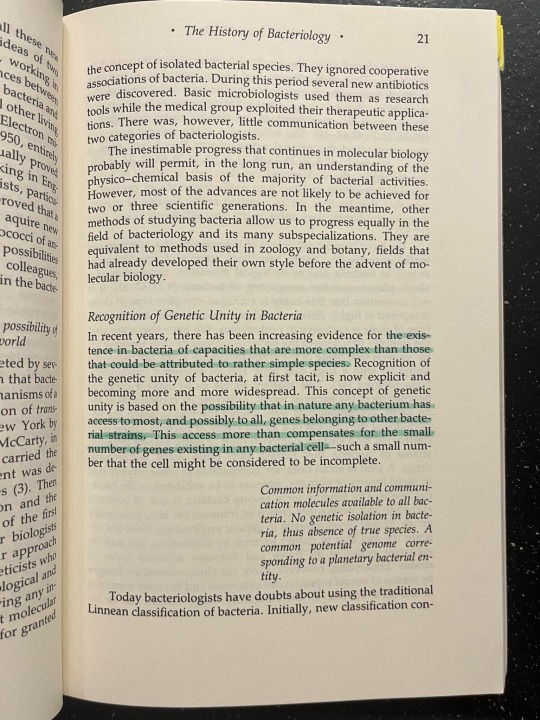
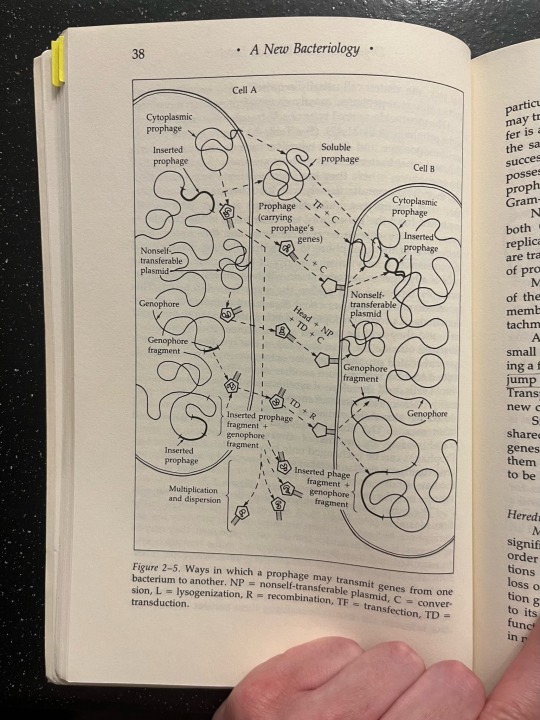
This copy needs repairs, but not so urgently I'll likely have them made any time soon. It's stable, at least for another decade or so. Interestingly a previous owner made notes in French.
The Why, Though?
Because I expected it to give me complicated feelings and also because it did. As a bonus, if I ever need to launder my sympathies for systematic radicalism as a passing academic interest, having a slightly ratty copy of this on my shelf will probably do the trick.
27 notes
·
View notes
Text
18/01/2023 ~ NTS Radio ~ Ryuichi Sakamoto Special ~ Further listening/viewing/reading
For Sakamoto's 70th birthday, his friends, peers and collaborators select 10 of their favourite tracks from his discography.
Featuring selections from Haruomi Hosono, Yukihiro Takahashi, Taeko Onuki, Ryoji Ikeda, Banana Yoshimoto and more!
youtube
Documentary filmed during the recording of Ongaku Zukan (1984)
Notes for further reading on the creation of Ongaku Zukan
youtube
Heartbeat Tour - Japan 1992
youtube
Sakamoto plays Sakamoto
Sakamoto Trio World Tour - 1996 - Japan
One of the first ever concerts to be live-streamed!
youtube
Plankton - 2016
A collaboration between visual artist Shiro Takatani and Sakamoto. Part of an art installation at Kyoto Municipal Museum of Art, showcasing Sardet’s images of microscopic plankton. The photos were paired with a video installation by Takatani and music composed by Sakamoto.
youtube
1995 - Music for Yohji Yamamoto Collection
youtube
youtube
This live performance would then be released as Garden of Shadows and Light - the first collaboration between Ryuichi Sakamoto and David Toop.
"The album’s title takes inspiration from the aesthetics of Japanese gardening. The spatial metaphor this suggests is apt, as listeners can imagine themselves wandering through a subtly changing environment, chancing on beautiful details and admiring them before moving on. We are led through a series of discrete moments, each uniquely shaded, whether by highly amplified small percussive sounds, austere electronic tones, or the mournful tones of Toop’s bass recorder. The course of the music follows a non-teleological drift, in which Sakamoto and Toop seem less concerned with establishing an overarching structure than in allowing each moment the space it needs to develop and breathe.
When Sakamoto eventually turns to the piano’s keyboard in the performance’s second half, the music becomes lushly enveloping as his jaggedly lyrical lines float against a backdrop of prepared guitar and field recordings. The music takes a radical, unexpected turn when Sakamoto picks up an electric guitar, with both players turning up the volume for a passage of distorted roar and shuddering feedback – bracing evidence of the unfettered, exploratory approach shared by these two uncategorisable musicians, beautifully documented here."
youtube
2000 - Lack of Love
L.O.L: Lack Of Love is a life simulation game developed created for Sega Dreamcast. The game was released only in Japan and was never exported to the West but it received a fan translation in 2020.
Sakamoto created the score for the game and he was also the game's scenario writer.
The musical score for L.O.L.: Lack of Love was created by film composer Ryuichi Sakamoto, who was also the game's scenario writer.
"The game's creator, Nishi and Sakamoto met at Club Eden via a mutual friend and, through a series of e-mails, began discussing James Lovelock’s Gaia hypothesis. This theory states that the earth's living organisms function in harmony and respond to ecological changes in order for the planet to sustain life. Nishi explained about the game's message: "We should care for other people, life, the environment and nature. Sakamoto came up with the title. We wanted to question the way in which our lifestyle lacks love"."
Recommended tracks: Artificial Paradise / Decision
youtube
In 1994, Japan Football Association asked Ryuichi Sakamoto to compose the instrumental song - "Japanese Soccer Anthem". The song played at the beginning of Japan Football Association-sponsored events.
youtube
Sakamoto appearing in Madonna's Rain music video!
4 notes
·
View notes
Text
Christians must not confuse ‘climate change’ with stewardship of the earth. They are not the same thing—not even close. The latter is biblical (Gen. 2:15), whereas the former is pagan (Rom.1:25). The entire climate change movement is grounded in the worship of Gaia (“mother earth”) or what is more technically known as “Gaia Theory” or the “Gaia Hypothesis,” which was first introduced by scientist James Ephraim Lovelock (1919-2022). It is worship of the creation rather than the Creator, which is nothing other than environmental idolatry.
-Darrell Harrison
#darrell harrison#christian blog#christianity#christians#christianquotes#quotes#gaia#gaiatheory#Gaia hypothesis
2 notes
·
View notes
Link
Article
Helena Norton
James Lovelock, the creator of the Gaia hypothesis, has died on his 103rd birthday. The climate scientist died at home on Tuesday surrounded by loved ones, his family said.
Lovelock, who was one of the UK’s most respected independent scientists, had been in good health until six months ago, when he had a bad fall.
Known as something of a maverick, he had been dispensing predictions from his one-man laboratory since the mid-1960s, and in his old age he continued to work.
His Gaia hypothesis posits that life on Earth is a self-regulating community of organisms interacting with each other and their surroundings. He said two years ago that the biosphere was in the last 1% of its life.
His family said: “Our beloved James Lovelock died yesterday in his home surrounded by his family on his 103rd birthday. To the world he was best known as a scientific pioneer, climate prophet and conceiver of the Gaia theory. To us he was a loving husband and wonderful father with a boundless sense of curiosity, a mischievous sense of humour and a passion for nature.
“Up until six months ago he was still able to walk along the coast near his home in Dorset and take part in interviews, but his health deteriorated after a bad fall earlier this year. He passed away at 9.55pm of complications related to the fall. The funeral will be private. There will be a public memorial service later. The family requests privacy at this time.”
Jonathan Watts, the Guardian’s global environment editor, who knew Lovelock and has been working on a biography about him, said: “The news is extremely sad, but what a life and what a legacy. Until very recently he was in good health and had a remarkable memory for events that happened almost a century ago. He was smart, funny and happy to share intimate details from his extraordinary life.
“It was thrilling to talk to one of the greatest minds Britain has ever produced. Here was a man who helped to shape many of the most important scientific events of the 20th century – Nasa’s search for life on Mars, growing awareness of the climate risks posed by fossil fuels, the debate over ozone-depleting chemicals in the stratosphere and the dangers of industrial pollution – as well as his work for the British secret services.”
Lovelock spent his life advocating for climate measures, starting decades before many others started to take notice of the crisis. By the time he died he did not believe there was hope of avoiding some of the worst impacts of the climate crisis.
Watts said: “Without Lovelock, environmental movements across the globe would have started later and taken a very different path. In the 1960s his ultrasensitive electron capture detector revealed for the first time how toxic chemicals were creeping into the air we breathe, the water we drink and the soil where we grow our food. He was the first to confirm the presence of fluorocarbons in the stratosphere and issued one of the earliest warnings that petroleum products were destabilising the climate and damaging the brains of children.
“His Gaia theory, conceived with the Pentagon consultant Dian Hitchcock and honed in collaboration with the US biologist Lynn Margulis, laid the foundations for Earth system science and a new understanding of the interplay between life, clouds, rocks and the atmosphere. He also warned, in clearer terms than any of his peers, of the dangers humanity posed to the extraordinary web of relations that make Earth uniquely alive in our universe.”
Lovelock was passionate about, and committed to, his work as he felt it imperative to warn humanity of the incoming climate catastrophe. He said in a lecture in 2011 that he had no plans for a comfortable retirement because of this.
“My main reason for not relaxing into contented retirement is that like most of you I am deeply concerned about the probability of massively harmful climate change and the need to do something about it now,” Lovelock said.
His Gaia theory was ridiculed when he first proposed it, by many who believed it was “new age nonsense”. It now makes up the basis of much of climate science. He was also controversial among his fellow environmental scientists and campaigners because he advocated for nuclear energy. Now, many agree with his view.
Another notable invention by Lovelock was a device that detected CFCs, which are damaging to the ozone layer.
He is survived by his wife, Sandra, his daughters Christine and Jane and his sons Andrew and John.
7 notes
·
View notes
Text
Restoring the Kinship Worldview (2022) by Wahinkpe Topa and Darcia Narvaez

I saw this title on the always-wonderful University of California, Berkeley’s The Greater Good Science Center site and was intrigued (https://greatergood.berkeley.edu/article/item/can_the_indigenous_worldview_build_a_better_future?_ga=2.232959710.1321401351.1669667825-1489903705.1660343467), having a profound interest in Native American perspectives, ancient and contemporary. Restoring the Kinship Worldview combines both to champion the ideology of kincentrism to restore place-based knowledge and return to an Earth-based consciousness in this Anthropocene era. Whatever version of a “god” one wants to believe in, through this ideological lens they all get rebranded as Nature. Sadly, “western” culture has nearly separated life from every corner of Nature, and thus we have created our own hell (p. 128). We collectively need to re-embrace a Nature-as-god, Earth-as-fragile-home mindset, if not as religion. Freud called this an “oceanic feeling”; to Maslow it was “peak experience”, and, to Sagan it was the romantic association of us being “made from stardust”. Beautiful, romantic, poetic.
Wahinkpe Topa (Four Arrows) speaks of a pet theory he has, where:
“ . . . starting with Hinduism, all of the organized religions have a foundation that relates to original Indigenous worldview. I propose that the enlightened founders, all the way up through Jesus Christ, saw the devolution of human civilization and created ideas for returning to our original loving nature. My theory is that religions are an effort to rectify the horrors of hierarchy and the loss of egalitarianism and Nature-based thinking. Indigenous worldview is thus prevention oriented, knowing about the potential but not experiencing life based on greed and division. Over time, the teachings of the religious founders were modified by the political and social mores of the times to create orthodoxy that weakened the original intent. Post-contact efforts became conventional for maintaining the religion itself.
If generosity is learned by observing the natural world and our place in it, as I believe it is, Indigenous worldview is a necessity for returning to life based on generosity, it seems” (pp. 162-3).
While my opinion couldn’t mean any less, I agree with him, even if I choose to ignore the “spiritual” or sentient nature of Nature. Lovelock and Margulis’s Gaia Hypothesis/Paradigm works well for me. The Indigenous worldview aligns with so much of “paganism”, Buddhism, Wiccan, druidic, and Transcendentalist perspectives too. This is an incredibly OLD way of looking at the world and understanding our humble place within in, and one I embrace wholeheartedly, but I’m nowhere near perfect yet. This is not a peace-on-earth perspective, though sometimes the readings feel that way. On the one hand, it is our <i>relationship</i> with and to Nature that needs to drastically metamorphose, and on the other it is our relationship to one another that needs to be dynamically reorganized. This all needs to be done quickly too. Time is not on our side here. Humankind needs to endure some growing pains in this transformation, but ultimately it will lead to greater reward for all life on Earth, finding balance and equilibrium, and nurturing a symbiotic relationship to Gaia.
If you haven’t yet seen the doc film The Year the Earth Changed on Apple TV, hosted by Sir David Attenborough, please do so. The COVID-19 pandemic was a monstrous occurrence (still ongoing) that’s severity could have easily been avoided if morons (beholden solely to their financial portfolios over human lives) weren’t in charge of half the world. One of the only good things the pandemic did was convincingly illustrate how when humankind slows down its consumption, traffic, pollution, and waste, the Earth and its biosystems can vigorously heal. This film is a teaching moment for tectonic change and shows that when humanity is encouraged to act differently, truly incredible things can happen, growing pains included.
Change is happening of course, but it is both equally small and yet equally significant, from nuclear fusion to quantum computing, from reversible-rust batteries to the growing use of solar panels and wind turbines, from “green concrete” to the proliferation of backyard gardens, discussions about “the future of work”, and the surging e-bike movement across the globe. Momentum, investment, and mind-shifts are required from everyone on the planet. We need to accomplish more with less. We need to consume less, waste less, breed less, and crave less. Replacing the mining of oil with the mining of lithium with the mining of cobalt won’t help. Listening to the voices of the global Indigenous community can lead us into a better future, but we must turn our ears and open our minds to what they have to say. This book is a fantastic starting point, and the sources they cite will help empower every reader to pursue the Indigenous worldview more purposefully. I’ll include my list below to make it easier on folks, but there are plenty more mentioned in the text (I’ve already read several of them, such as Sand Talk: How Indigenous Thinking Can Save the World by Tyson Yunkaporta). Here’s to a better, more peaceful, inclusive, and humanistic-driven future.
Spirits of Blood, Spirits of Breath: The Twinned Cosmos of Indigenous America by Barbara Alice Mann (2016)
Neurobiology and the Development of Human Morality: Evolution, Culture, and Wisdom by Darcia Narvaez (2014)
Mother Earth Spirituality: Native American Paths to Healing Ourselves and Our World by Ed McGaa (2011)
Unlearning the Language of Conquest: Scholars Expose Anti-Indianism in America by Four Arrows (Don Trent Jacobs) (2010)
Columbus and Other Cannibals: The Wetiko Disease of Exploitation, Imperialism, and Terrorism by Jack Forbes (2008)
Concentric Ecology: Indigenous Perceptions of the Human-Nature Relationship by Enrique Salmon (2000)
The Spell of the Sensuous by David Abram (1997)
Yurugu: An African-Centered Critique of European Cultural Thought and Behavior by Marimba Ani (1994)
Africans and Native Americans: The Language of Race and the Evolution of Red-Black Peoples by Jack Forbes (1993)
2 notes
·
View notes
Link
During the 1970s, inventor/environmentalist James Lovelock and evolutionary biologist Lynn Margulis proposed the Gaia Hypothesis. This theory posits that Earth is a single, self-regulating system where the atmosphere, hydrosphere, all life, and their inorganic surroundings work together to maintain the conditions for life on the planet. This theory was largely inspired by Lovelock’s work with NASA during the 1960s, where the skilled inventor designed instruments for modeling the climate of Mars and other planets in the Solar System. According to this theory, planets like Earth would slowly grow warmer and their oceans more acidic without a biosphere that regulates temperature and ensures climate stability. While the theory was readily accepted among environmentalists and climatologists, many in the scientific community have remained skeptical since it was proposed. Until now, it has been impossible to test this theory because it involves forces that work on a planetary scale. But in a recent paper, a team of Spanish scientists proposed an experimental system incorporating synthetic biology that could test the theory on a small scale. The team included researchers from the Catalan Institution for Research and Advanced Studies (ICREA), the Universitat Pompeu Fabra’s Complex Systems Lab (UPE-CSL), the European Molecular Biology Laboratory (EMBL), and the Santa Fe Institute (SFI). Their paper, “A Synthetic Microbial Daisyworld: Planetary Regulation in the Test Tube,” recently appeared in the Journal of the Royal Society Interface. As they describe, their proposed test consists of two engineered micro-organisms in a self-contained system to see if they can achieve a stable equilibrium. An image of Earth taken by the Galileo spacecraft in 1990. Credit: NASA/JPL In response to challenges, Lovelock and British marine and atmospheric scientist Andrew Watson (a postgrad student of Lovelock’s) created a computer model named Daisyworld in 1983. The model consisted of an imaginary planet orbiting a star whose radiant energy slowly increases or decreases (aka. stellar flux). In the first (biological) case, the planet has a simple biosphere consisting of two species of daisies with different colors (black and white) that cause them to absorb different amounts of solar radiation. The black or white daises increase based on how much solar energy the planet receives, and changes in their relative populations stabilize the planet’s climate over time despite fluctuations in energy from the star. In the second (non-biological) case, the planet’s temperature is directly related to the amount of energy it receives from the star. Previously, no means existed to test this model since it was planetary in scale. This proposed test was inspired by recent research in fermentation, which typically requires finely tuned external controls to ensure stable, regulated conditions. In this experimental setup, one strain senses if the environment is becoming too acidic and counteracts it, while the other strain senses if the environment is becoming too basic and acts to increase acidity. Ricard Solé, an ICREA research professor, head of the Complex Systems Lab, and an external professor at the SFI, was a co-author of the paper. As he explained in a recent SFI news release: “There’s been recent work in trying to see if you can engineer microorganisms for fermentation so that they can self-regulate. That was the key inspiration. Because these strains act on the environment, and the environment affects them, this creates a closed causal loop. The idea is to show that under very broad conditions, they will stabilize to a constant pH level, as predicted by the original theory.” Artist’s impression of an Earth-like exoplanet orbiting Gliese 667 C, part of a triple star system. Credit: ESO Solé and several of his students developed the experiment during a visit to SFI. It has the potential to answer long-standing questions regarding planet-wide regulatory systems. In short, it offers the first possible means for testing the Gaia Hypothesis and demonstrating the vital role life plays in regulating biospheres and maintaining habitable conditions. In addition to Earth’s climate, this research could have significant implications for measuring habitability and climate stability on other planets, particularly exoplanets. Further Reading: Santa Fe Institute, Journal of the Royal Society The post Can the Gaia Hypothesis Be Tested in the Lab? appeared first on Universe Today.
1 note
·
View note
Text
Indeed, the "mosaic" or mixture of male and female characteristics found in intersexual animals such as gynandromorphs is used by some Gaian theorists as a model of multiplicity within oneness, the transformation of disjuncture into wholeness – in other words, the very image of earth itself.
"Biological Exuberance: Animal Homosexuality and Natural Diversity" - Bruce Bagemihl
#book quote#biological exuberance#bruce bagemihl#nonfiction#mosaic#intersex#gynandromorph#gaia hypothesis#gaia theory#multiplicity#transformation#disjuncture#wholeness#earth
0 notes
Text
For other uses of "Gaia", see Gaia (disambiguation).The study of planetary habitability is partly based upon extrapolation from knowledge of the Earth's conditions, as the Earth is the only planet currently known to harbour life (The Blue Marble, 1972 Apollo 17 photograph).Part of a series onRights of natureMovements and schools of thought
Earth jurisprudence
Deep ecology
Wild law
Environmental personhood
Traditional worldviews
Ubuntu
Pachamama
Sumak Kawsay
Scholars and authors
Roderick Nash
Thomas Berry
Cormac Cullinan
John Muir
Aldo Leopold
Christopher D. Stone
Vandana Shiva
Other
Animal rights
Gaia hypothesis
Rights of nature law
v
t
e
The Gaia hypothesis (/ˈɡaɪ.ə/), also known as the Gaia theory, Gaia paradigm, or the Gaia principle, proposes that living organisms interact with their inorganic surroundings on Earth to form a synergistic and self-regulating, complex system that helps to maintain and perpetuate the conditions for life on the planet.
For other uses of "Gaia", see Gaia (disambiguation).The study of planetary habitability is partly based upon extrapolation from knowledge of the Earth's conditions, as the Earth is the only planet currently known to harbour life (The Blue Marble, 1972 Apollo 17 photograph).Part of a series onRights of natureMovements and schools of thought
Earth jurisprudence
Deep ecology
Wild law
Environmental personhood
Traditional worldviews
Ubuntu
Pachamama
Sumak Kawsay
Scholars and authors
Roderick Nash
Thomas Berry
Cormac Cullinan
John Muir
Aldo Leopold
Christopher D. Stone
Vandana Shiva
Other
Animal rights
Gaia hypothesis
Rights of nature law
v
t
e
The Gaia hypothesis (/ˈɡaɪ.ə/), also known as the Gaia theory, Gaia paradigm, or the Gaia principle, proposes that living organisms interact with their inorganic surroundings on Earth to form a synergistic and self-regulating, complex system that helps to maintain and perpetuate the conditions for life on the planet.
0 notes
Text
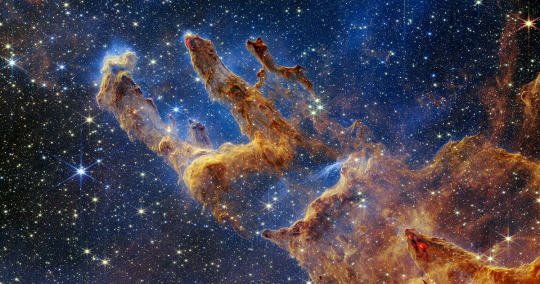
The question of what life is — how atoms and molecules become living cells, what differentiates a rock from the lichen on it and a robot from a human being — has shaped human thought for as long as we have been thinking. For a long time, it was believed that living beings are animated by some mysterious vital force beyond mere matter — a spark of life, hidden deep within. This view, known as vitalism, crumbled on the anatomy table of Romantic science when the scalpel found no mysterious soul-organ super-added by a divine hand. Everything we are, these heretical discoveries intimated, must be housed in the body, must arise from this mortal matter, must be the product of physical forces that “animate the lifeless clay,” as Mary Shelley (who frequented London’s science lectures) wrote in Frankenstein — that far-seeing reckoning with the mystery of life weighed against its materiality.
Within a century, just before he sparked the dawn of artificial intelligence, the young Alan Turing was bending his pliant mind around the notion that we are built of “living bricks set in dead mortar.”

Born not long after the development of cell theory began revolutionizing our understanding of life, at a time when the cell was established as the basic biological unit but its inner workings remained an enigma, Just set out to understand how a cell becomes a living organism. Studying a sand dollar during fertilization, he made a landmark discovery of how the egg cell directs its own development — anathema to prior understanding of the inception of life.
A few years before James Baldwin did the same for the same reasons, Just moved to Europe to live and work in self-elected exile freer, though never entirely free, from his homeland’s prejudices. As a world war was breaking out, he published his magnum opus — The Biology of the Cell Surface (public library) — recounting his revelatory research in uncommonly poetic prose bridging the scientific and the existential.
Half a century before the evolutionary biologist Lynn Margulis gave us her Gaia hypothesis of inter-relation, anchored in her view that “life is a unitary phenomenon, no matter how we express that fact,” Just anticipates the the new biology of poetic ecology and writes:
We feel the beauty of Nature because we are part of Nature and because we know that however much in our separate domains we abstract from the unity of Nature, this unity remains.
This unity holds up at every scale, from the atoms to the stars:
Nature is both continuous and corpuscular. In the former sense, we pass from lower to higher revelations of organization almost insensibly and with scarcely a break. Every form of matter follows upon another. In the latter sense, we recognize breaks in natural states from electron to atom, from atom to molecule, from molecule to compound, and from compounds in association to living matter. But even conceived of as corpuscular, matter, as we know it, is never purely discrete and absolutely independent from the remainder of nature. Whether we study atoms or stars or that form of matter, known as living, always must we reckon with inter-relations. The universe, however much we fragment it, abstract it, ever retains its unity.
The egg cell also is a universe. And if we could but know it we would feel in its minute confines the majesty and beauty which match the vast wonder of the world outside of us. In it march events that give us the story of all life from the first moment when somehow out of chaos came life and living.
Art by Luisa Uribe from The Vast Wonder of the World — a picture-book biography of Ernest Everett Just
Adding to “the vast wonder of the world,” rather than subtracting from it, is the knowledge that all this ravishing complexity, all this breathtaking pulsating beauty, is made of the most elementary building blocks:
The realm of living things being a part of nature is contiguous to the non-living world. Living things have material composition, are made up finally of units, molecules, atoms, and electrons, as surely as any non-living matter. Like all forms in nature they have chemical structure and physical properties, are physico-chemical systems. As such they obey the laws of physics and chemistry. Would one deny this fact, one would thereby deny the possibility of any scientific investigation of living things. No matter what beliefs we entertain, the noblest and purest, concerning life as something apart from physical and chemical phenomena, we can not with the mental equipment which we now possess reach any estimate of living things as apart from the remainder of the physico-chemical world.
Living things, Just observes, are not made of some special stuff but of the commonest chemical elements, so the difference between life and non-life cannot be attributed to matter alone. The difference, he argues, is not one of composition but of organizing principle — a kind of choreography, orchestrating motion in time. A year before Borges insisted that time is the substance we are made of, Just writes:
Living matter has an organization peculiar to itself. Nowhere except in the living world does matter exhibit this organization. Life, even in the simplest animal or plant, so far as we know, never exists apart from it. Resting above and conditioned by non-living matter, life perhaps arose through the chance combination of the compounds which compose it. But who knows? A living thing is not only structure but structure in motion. As static, it reveals the superlative combination of compounds of matter; as a moving event, it presents the most intricate time-pattern in nature. Life is exquisitely a time-thing, like music.
Anatomy of a bird by French artist Paul Sougy. (Available as a print, benefitting The Nature Conservancy.)
An epoch before Just, responding to the death of vitalism on the anatomy table, Emily Dickinson had captured the irreducibility of life, the way its dissection into parts will never account for the organizing principle that harmonizes the whole:
Split the Lark — and you’ll find the Music…
Scarlet Experiment!…
Now, do you doubt that your Bird was true?
#We Are the Music#We Are the Spark: Pioneering Biologist Ernest Everett Just on What Makes Life Alive#Life#Ernest Everett
1 note
·
View note
Quote
The creator of the Gaia hypothesis and the greatest environmental thinker of our time has produced an astounding new theory about the future of life on Earth. James Lovelock argues that the anthropocene - the age in which humans acquired planetary-scale technologies - is, after three centuries, coming to an end. A new age - the novacene - has already begun.
New beings will emerge from existing artificial intelligence systems. They will think 10,000 times faster than we do and will regard us as we now regard plants. The cruel, violent machine takeover imagined by sci-fi writers will not happen: these hyper-intelligent beings will be as dependent on the health of the planet as we are. They will need the planetary cooling system of Gaia to defend from the increasing heat of the sun. Gaia depends on organic life. We will be partners in this project. It is crucial, Lovelock argues, that the intelligence of Earth survives and prospers. We are at present the only beings capable of understanding the cosmos, but he speculates that the novacene could be the beginning of a process that will see intelligence suffusing the entire cosmos. At the age 100, Lovelock has produced the most compelling work of his life.
Novacene: The Coming Age of Hyperintelligence - James Lovelock - Google Books
1 note
·
View note
Text
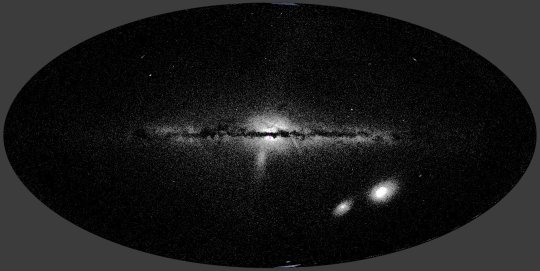


Masses of RR Lyrae stars revealed through their pulsations
RR Lyrae stars are old, pulsating stars that burn helium in their cores for fuel. Their progenitors were similar to our sun, but they are now much larger and brighter than our sun. We know of hundreds of thousands of RR Lyrae stars within the Milky Way, and we can use them to study how our galaxy has evolved since its formation. However, one fundamental measurement has so far eluded astronomers: there has been no reliable way to determine the masses of RR Lyrae stars—until now.
RR Lyrae stars are also pulsating stars, with pulsations driven by a "stellar engine" known as the kappa mechanism: a process by which a sub-surface layer inside the star containing partially ionized helium modulates the amount of energy that can leave the stellar core. This layer acts as a heat engine, so the envelopes of pulsating stars expand and contract periodically, as waves propagate through their interiors. This phenomenon is observed by astronomers as periodic changes in brightness.
The kinds of waves that propagate through a particular star depend on the physical conditions inside the star. As a result, we can study a star's internal properties based on its pulsations, much like studying the inside of the Earth through seismology. In the case of stars, this field is called asteroseismology.
For many years, RR Lyrae stars were thought to be simple radial pulsators: stars whose spherical symmetry is preserved during pulsation. With only one two pulsation modes present, it was not possible to study them by asteroseismology, which requires the identification of multiple modes of pulsation.
In the last decade, however, excellent ground and space-based observations revolutionized our view on RR Lyrae stars. Such modern observations have revealed that RR Lyrae stars can have additional, non-radial periodicities, just with very small amplitudes.
The origin of these modes was unknown for a long time, but the growing number of stars showing these periodicities facilitated the development of a hypothesis that the observed signals were due to non-radial modes of pulsations of degrees 8 or 9. This means that 8 or 9 nodal lines divide the surface into separate zones. Modes at such degrees were previously thought to be unobservable for distant stars.
Nevertheless, these newly identified pulsation modes enabled the application of asteroseismic methods to study RR Lyrae stars, and in particular, to address the long-standing problem of mass measurements. Fortunately, with these additional non-radial modes, if the theory correct, the masses of RR Lyrae stars can be estimated using asteroseismology.
This mass determination procedure was successfully performed by Drs. Henryka Netzel, László Molnár, and Meridith Joyce, researchers at the Konkoly Observatory in Budapest, Hungary, for seven well-constrained RR Lyrae stars. They combined high-precision observations from the Kepler, TESS, and Gaia space telescopes with theoretical models of stellar pulsations for these stars to test the theory behind the high-degree modes in RR Lyrae stars.
Using independent observations, they determined constraints on physical parameters such as the observed brightness or metallicity of these stars. They then computed a grid of theoretical models of RR Lyrae stars along various parameters (such as luminosity, metallicity, temperature, and, most importantly, mass) with the MESA-RSP stellar pulsation code and tested whether such models would show pulsations and, if so, what the pulsation periods of the different modes would be.
The results, published by lead author Dr. Netzel (now a postdoc at EPFL in Lausanne, Switzerland) and her colleagues in the journal Monthly Notices of the Royal Astronomical Society, show that periodicities in RR Lyrae stars can be successfully reproduced using the proposed identification of 8–9 degree non-radial modes.
The authors successfully derived asteroseismic masses for the stars studied, ranging from 0.5 to 0.85 solar masses, in good agreement with the predictions of stellar evolution models and other indirect means of estimating mass. They now plan to extend this research and use this new method to determine masses for other RR Lyrae pulsators and to compare them with the masses of stars in evolutionary phases before and after the RR Lyrae stage of stellar life.
TOP IMAGE....The distribution of known RR Lyrae stars in the sky, based on identifications from the European Gaia mission. The thick disk of the Milky Way and the two Magellanic clouds are clearly visible, as is the core of the Sagittarius dwarf galaxy, the vertical feature just below the center of the Milky Way. Credit: Gaia Collaboration (2022) / H. Netzel / made with Aladin
CENTRE IMAGE....Radial pulsation (top) drives the characteristic brightness variations of RR Lyrae stars (middle). High-precision photometry can, however, reveal the signs of small-amplitude non-radial pulsations hidden beneath that large signal (bottom). Credit: H. Netzel (EPFL)
LOWER IMAGE....Results from the asteroseismic model fits for the seven RR Lyrae stars, plotted onto the Hertzsprung-Russell diagram (stellar luminosity vs surface temperature). Blue and red lines mark the edges of the instability strip within which stars pulsate. Dots are the positions of the best-fitting models, and boxes mark the uncertainty ranges. Colors indicate the estimated mass of each star: as the figure indicates, brighter RR Lyrae stars have generally higher masses. Credit: Netzel et al. (2023) / MNRAS
0 notes
Text

•Assignment name: #00Sketch
•Tools: Medibang Paint
•Description: A logo for a secret project of making an A.I. that unites everyone on earth together as a whole called "G.A.I.A."
•Self-evaluative feedback: In my game's settings, this A.I. was designed to always calculate the best result for humans' actions and basically guide all humans to the best result, reaching "the perfect earth" which everyone will work together sharing the same goal, and it is named "G.A.I.A." for this reason too (Gaia Hypothesis is a theory that earth is a gigantic living being and everything that's on it is just its cells that works in a balance that keeps the earth alive), thus when desining this logo, I want to make it feel like something that's simplistic like corporation logos, but deliver a mild uneasiness hidden behind the surface. The elements I fianlly picked to make this logo is an eye opening, symbolizing the earth will have its own "concious" (which is made by everyone on earth sharing the same thought, making a big collective concious), and the pupil of the eye is the symbol of the earth (a circle with a + in it). The upside down triangle with a line across it is also another symbol of earth that's surrounding the eye, symbolizing that the earth give birth to us, so now it's time for us to be together and let the earth awaken.
0 notes